How to install water pipes
If you choose water pipes according to GOST 322-62-75, it means that you stopped on steel, but if you preferred GOST 18599-2001, then it means that the wiring will be made of polyethylene, and GOST P 15234-2003 points to polypropylene .
All these materials are widely used for the installation of water supply and sewage systems, although in some situations they prefer one of them for various reasons. We will talk below about the materials and situations in which preference is given to certain materials, as well as show you the video in this article.
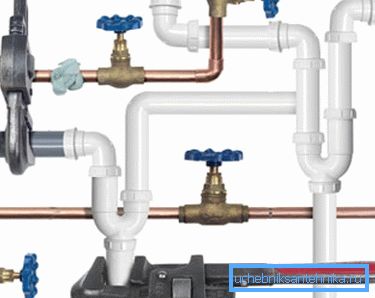
Water pipes
Note. A system that provides uninterrupted water supply for food or technical purposes from a water intake node is called running water. In addition, the system of water supply to different points in the room is called wiring.
Metal pipes
| Diameter of passage (mm) | Outer diameter (mm) | Ordinary | reinforced | ||
| Wall (mm) | Weight per meter (kg) | Wall (mm) | Weight per meter (kg) | ||
| 6 | 13.5 | 2.25 | 0.52 | 2.75 | 0.73 |
| ten | 17.0 | 2.25 | 0.82 | 2.75 | 0.97 |
| 15 | 21.25 | 2.25 | 1.25 | 3.25 | 1.44 |
| 20 | 26.75 | 2.25 | 1.63 | 3.50 | 2.01 |
| 25 | 33.5 | 3.25 | 2.42 | 4.0 | 2.91 |
| 32 | 42.25 | 3.25 | 3.13 | 4.0 | 3.77 |
| 40 | 48.0 | 3.50 | 3.84 | 4.25 | 4.58 |
| 50 | 60.0 | 3.50 | 4.88 | 4.5 | 6.16 |
| 70 | 75.5 | 3.75 | 6.64 | 4.5 | 7.88 |
| 80 | 88.5 | 4.0 | 8.34 | 4.75 | 9.81 |
| 100 | 114.0 | 4.0 | 10.85 | 5.0 | 13.44 |
| 125 | 140.0 | 4.50 | 15.01 | 5.5 | 18.24 |
| 150 | 165.0 | 4.50 | 17.81 | 5.5 | 21.63 |
The most demanded diameter of water pipes in mm
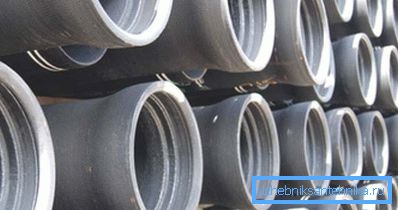
- Cast iron is not used very often for plumbing, as it is associated with certain difficulties - in this case, transportation and installation require great care, as it is a rather fragile material, although the service life of such pipes is about 80 years. In addition, the instruction indicates that the permeability of the cast-iron plumbing decreases very little (compared to steel), since the growth of various microorganisms here is very slow. Such pipes are usually laid in a trench as a trunk line.
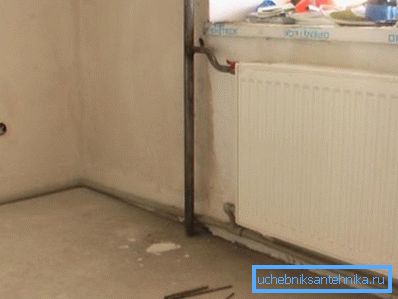
- Steel is considered to be the most durable material of all that is used to supply water, but there is a significant drawback here - its optimal operating period is over 20 years. The fact is that even if such pipes are provided with constant care (painting), they will still be covered by corrosion from the inside, which reduces the quality of drinking water and the flowability of the water supply, which, in turn, increases the cost of supply, as you need to increase head In addition, corrosion entails various emergencies such as breakthroughs and leaks that require repair, and, consequently, money for its implementation.
- Also, the installation of water pipes made of steel is rather inconvenient in technical terms - connections are made through transitional threaded couplings for pipes or gas-electric welding, from which the cost of installation increases. However, if we talk about trunk lines, in most cases it is steel that is used as the most durable material that can withstand any pressure created by the pump station.
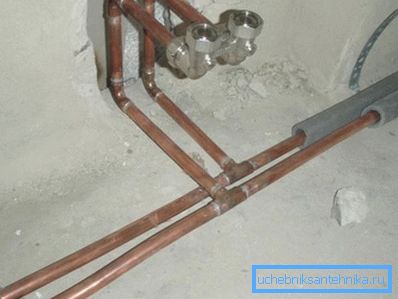
- Among all metal products, copper has the greatest strength - the replacement and repair of water pipes made of copper, subject to all rules of operation, is possible only once a hundred years.! Such an advantage is explained by the fact that there is no corrosion on them, therefore, the quality of drinking water and throughput always remain at a high level and are used for both hot and cold water supply and for heating. But this material, in view of its high cost, is usually used only indoors, and the connection with steel requires the involvement of specialists, since oxidation occurs when the heterogeneous metals dock.
Polymer pipes
Note. All polymer pipes differ significantly from each other, as they are made from different materials, therefore, GOST will also be different for them. So, they can be from polyvinyl chloride (PVC), polypropylene (PP or PPR), as well as from polyethylene (PE). Polymers have a clear advantage over metals - due to the complete absence of corrosion and oxidation, they can be exploited for centuries.

Polyvinyl chloride is used for plumbing, but most often they are still used for sewage and placed in a trench (underground), although the wiring (especially indoors) can be carried out on top. Such installation can be called a budget option, since the cost of material is quite low.
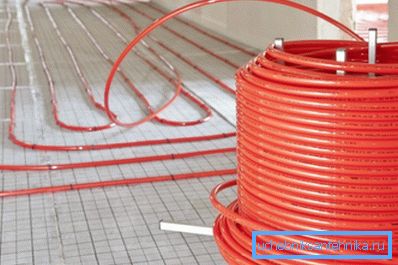
Polyethylene is widely used in seismically active zones, because, due to its elasticity, it can stretch by 7% of its total volume, which is also very valuable for installation of systems at low temperatures and hydraulic shocks. Almost always, such material is used in the private sector for the line between the water intake (well or well) and the distribution hub in the house. Connections are made using compression fittings.
Cross-linked PE is made under the influence of high pressure, so the pipe of this material is able to withstand high temperatures (underfloor heating) and additional loads. One of the exemplary modifications of PE can be called metal-plastic, where the inner layer is made of cross-linked polyethylene, then there is a reinforcement layer of aluminum foil, and at the top is a layer of ordinary PE.

In recent years, the installation of water pipes, more precisely, its distribution, mainly made of polypropylene, as the most suitable material from a technical and technological point of view. So, such a pipe can be either solid-walled (PN10, PN16) or reinforced (PN20, PN25), but besides this, there are differences in the reinforcement, which may be fiberglass, or, more commonly, aluminum foil.
If PN10 and PN16 are used only for cold water, then PN20 and PN25 can be used both for cold and hot water supply, as well as for the heating radiator circuit.
In addition, there are differences in the location of the reinforcing layer, for example, the PN25 foil is not in the middle of the polypropylene wall, but closer to the surface, which complicates the welding work during installation.
It turns out that the diameter of the foiled layer coincides with the internal diameter of the soldering iron nozzle, therefore, docking with the fitting will lose the full possibility of hot adhesion. In this regard, the foil is cleaned and since it is rather difficult to do it yourself (with a knife), then a special cutter is used for cleaning.
The nuances of editing

If you are in the private sector and think about what pipes to install plumbing, then the most popular solution here will be polyethylene for the street and polypropylene for the room (in the apartment, the choice will be limited to one PPR, since the main supply line is already there). This, of course, does not mean that you should not use metal or metal-plastic, but the first option is the most practical and economical.
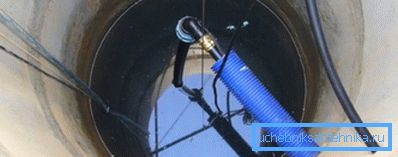
Regardless of what kind of pump will supply water - submersible or surface (hydrophore) - from the well or well to the house you need to mount a line, which in our case will be made of a polyethylene pipe with a diameter of 32 mm. Turns 90? and connections here are made by compression fittings for pipes (you see the turn in the top photo), and the transition to polypropylene with a cross section of 20 mm or 25 mm is also using a fitting, but already a reducing one.
When laying PE in a trench, one should not forget that it is still not metal, and sharp hard objects, such as stones, glass, wire, metal fragments, can cause a rupture or cut.
In this regard, a sand cushion with a height of 20-50 mm is poured at the bottom of the trench, onto which a polyethylene hose is placed, and a layer of sand is again poured over to minimize the possibility of contact with sharp hard objects and only after that fill the ground.
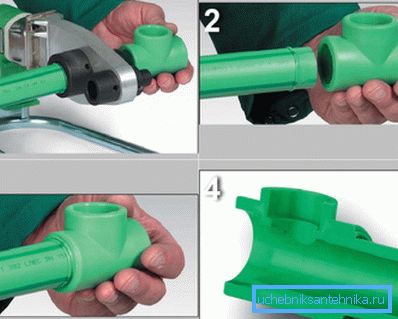
Welding works are carried out with the help of a special electric soldering iron, and you can see the steps of soldering in the selection of photos above. When installing, be careful that stray currents do not occur in water pipes, which appear either when the radiators are zeroed (this is how electricity is stolen) or when the electric wire is exposed, for example, when it is pulled through a plasterboard frame.
Note. When installing on the street, you should somehow designate the place of laying the highway, and here it’s not even how to find a water pipe under the ground, but, most likely, how not to damage it during any works that will be carried out nearby.
Conclusion
If the water pipes from the inside are not susceptible to corrosion and do not overgrow, then this is one of the decisive factors when choosing a material. It is for this reason that we recommended polymers for mounting.